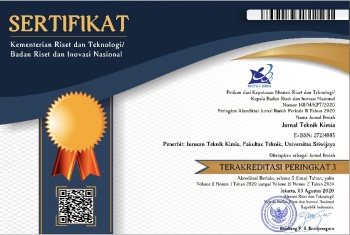Producing liquid organic fertilizer (LOF) by combining rice straw waste with local microorganisms (MOL) to enhance the growth of rice plants
Abstract
Rice straw is a byproduct of rice harvesting that is often underutilized or discarded, contributing to agricultural waste. Finding effective ways to utilize rice straw could reduce waste and potentially enhance agricultural productivity. This study investigates the impact of rice straw and Local Microorganisms (MOL) on rice plant growth through liquid organic fertilizer (LOF). Employing a 2 x 2 factorial randomized regular two-level factorial design with three replications and blocks, the study assessed the impact of varying levels of rice straw (50 grams and 100 grams) and MOL application (200 mL and 400 mL) on rice plant height over a 7-day period. Results indicate that the combination of 50 grams of rice straw and 200 mL of MOL yielded the highest average plant height of 4.91 cm. Notably, MOL (B) exerted the most substantial influence on plant height, with the interaction between rice straw (A) and MOL also contributing, albeit to a lesser degree. Optimization analysis identified the optimal combination of 50 grams of rice straw and 266 mL of MOL for maximizing rice plant growth, underscoring the potential of integrating these elements into agricultural practices. This approach not only mitigates agricultural waste but also reduces dependence on chemical fertilizers, aligning with principles of sustainable agriculture. Moreover, the study robust experimental design and statistical analysis using Design Expert Version 13 validate the reliability and applicability of these findings in agricultural settings.
References
An, N., Zhang, L., Liu, Y., Shen, S., Li, N., Wu, Z., Yang, J., Han, W., & Han, X. (2022). Biochar application with reduced chemical fertilizers improves soil pore structure and rice productivity. Chemosphere, 298, 134304.
Atman, & Nurnayetti. (2014). Eksistensi pertanian organik dalam perkembangan agribisnis padi sawah sumatera barat. Bunga Rampai Pengembangan Agribisnis. Inovasi Teknologi dan Perbaikan Sistem Dalam Pengembangan Agribisnis(1), 162-175.
Bps. (2021). Luas Panen dan Produksi Padi di Indonesia 2021 (Vol. 13).
Delgado, A., & Gómez, J. A. (2016). The soil. Physical, chemical and biological properties. Principles of agronomy for sustainable agriculture, 15-26.
Kumar, N., Chhokar, R., Meena, R., Kharub, A., Gill, S., Tripathi, S., Gupta, O., Mangrauthia, S., Sundaram, R., & Sawant, C. (2021). Challenges and opportunities in productivity and sustainability of rice cultivation system: a critical review in Indian perspective. Cereal research communications, 1-29.
Kurniastuti, T., & Puspitorini, P. (2023). Pelatihan Pembuatan Pupuk Organik di P4S Kelurahan Karangsari Kecamatan Sukorejo Kota Blitar. 2(1), 111-116.
Lizcano Toledo, R. (2022). Strategies to improve phosphorus availability and reduce environmental impact in rice agrosystems.
Mahroof, M., Dar, R. A., Nazir, R., Ali, M. N., & Ganai, B. A. (2024). Valorization of rice straw and vascular aquatic weeds for sustainable prebiotic hemicellulosic autohydrolysate production: Extraction, characterization and fermentability. Environmental Science and Pollution Research, 1-16.
Pahalvi, H. N., Rafiya, L., Rashid, S., Nisar, B., & Kamili, A. N. (2021). Chemical fertilizers and their impact on soil health. Microbiota and Biofertilizers, Vol 2: Ecofriendly tools for reclamation of degraded soil environs, 1-20.
Pardosi, A. H., Irianto, & Mukhsin. (2014). Respons Tanaman Sawi terhadap Pupuk Organik Cair Limbah Sayuran pada Lahan Kering Ultisol. Prosiding Seminar Nasional Lahan Suboptimal 2014, Palembang 26-27 September 2014(September), 77-83.
Pratiwi, S. H. (2016). Growth and Yield of Rice (Oryza sativa L.) on various planting pattern and addition of organic fertilizers. Gontor AGROTECH Science Journal, 2(2), 1-19. https://doi.org/10.21111/agrotech.v2i2.410
Rahmi, A., & Jumiati, D. a. N. (2007). Pengaruh Konsentrasi dan Waktu Penyemprotan Pupuk Organik Cair Super ACI terhadap Pertumbuhan dan Hasil Jagung Manis. J. Agritop, 26(3), 105-109.
Ramandani, A. A., Aji, S. P., Shintawati, S., & Hargiawan, A. (2023a). Rasio Limbah Jerami Padi (Oryza Sativa L.) dan Mikroorganisme Lokal (MOL) Dalam Produksi Pupuk Organik Cair. JoASCE (Journal Applied of Science and Chemical Engineering), 1(2), 58-64.
Ramandani, A. A., Aji, S. P., Shintawati, S., Hargiawan, A., & Herlambang, M. J. (2023b). Pengaruh Limbah Batang Pisang (Musa Paradisiaca) Dan Jerami Padi (Oryza Sativa L.) Terhadap Produksi Biogas. JoASCE (Journal Applied of Science and Chemical Engineering), 1(2), 44-50.
Rezania, S., Din, M. F. M., Taib, S. M., Sohaili, J., Chelliapan, S., Kamyab, H., & Saha, B. B. (2017). Review on fermentative biohydrogen production from water hyacinth, wheat straw and rice straw with focus on recent perspectives. International Journal of Hydrogen Energy, 42(33), 20955-20969.
Sajiwo, W., Prihandarini, R., & Suharjanto, T. (2016). Kajian Pemanfaatan Mikroorganisme dan Pupuk Organik terhadap Pertumbuhan dan Produksi Tanaman Sselada Keriting (Lactuca sativa, L.). Jurnal Ilmu-Ilmu Pertanian, 10(2), 171-178.
Suhastyo, A. A., & Raditya, F. T. (2019). Respon Pertumbuhan dan Hasil Sawi Pagoda (Brassica Narinosa) terhadap Pemberian Mol Daun Kelor. Agrotechnology Research Journal, 3(1), 56-60. https://doi.org/10.20961/agrotechresj.v3i1.29064
Supartha, I. N. Y., Wijana, G., & Adnyana, G. M. (2012). Aplikasi Jenis Pupuk Organik pada Tanaman Padi Sistem Pertanian Organik. E-Jurnal Agroekoteknologi Tropika, 1(2), 98-106.
Yasin, S. M. (2016). Respon Pertumbuhan Padi (Oryza Sativa L.) Pada Berbagai Konsentrasi Pupuk Organik Cair Daun Gamal. Jurnal Galung Tropika, 5(1), 20-27. https://jurnalpertanianumpar.com/index.php/jgt/article/view/129

This work is licensed under a Creative Commons Attribution 4.0 International License.










